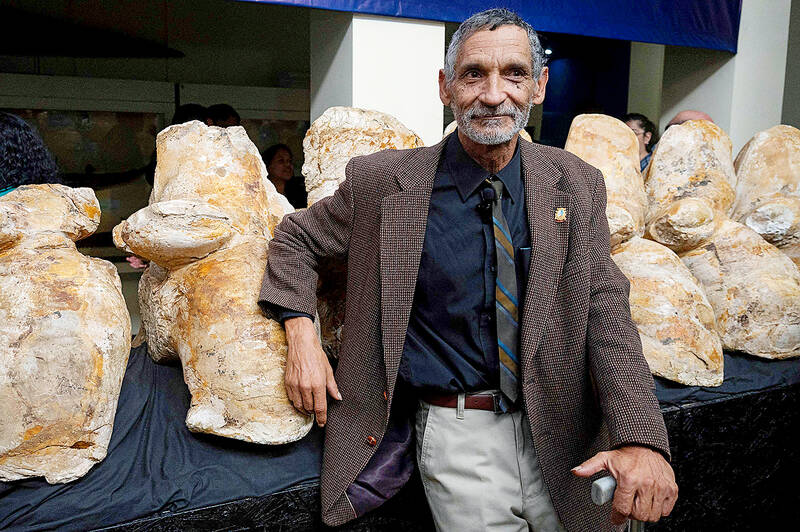Look out, blue whale — there’s a new contender for your heavyweight title.
A newly discovered whale that lived nearly 40 million years ago could be the heaviest animal to have ever lived, based on a partial skeleton found in Peru, scientists said on Wednesday.
The modern blue whale has long been considered the largest and heaviest animal ever, beating out all the giant dinosaurs of the distant past.

Photo: AFP
But Perucetus colossus — the colossal whale from Peru — may have been even heavier, according to a study published in the journal Nature.
Extrapolating from some massive bones found in the Peruvian desert, an international team of researchers estimated that the animal had an average body mass of 180 tonnes.
That would not take the heavyweight title by itself. The biggest blue whale ever recorded weighed 190 tonnes, according to Guinness World Records.
But the researchers estimated the ancient whale’s weight range was between 85 and 340 tonnes, meaning it could have been significantly larger.
The first fossil of the ancient whale was discovered back in 2010 by Mario Urbina, a palaeontologist who has spent decades searching the desert on the southern coast of Peru.
“There is no record of the existence of an animal as large as this, it is the first, that’s why nobody believed me when we discovered it,” Urbina said in Lima. According to the researcher, this discovery “is going to cause more questions than answers and give the rest of the palaeontologists a lot to talk about.”
The remains were presented to the public for the first time during a press conference at the Natural History Museum in the Peruvian capital, where they are being displayed. The researchers estimate that the animal reached about 20 meters in length.
REWRITING CATACEAN HISTORY
The researchers were careful not to declare the ancient whale had broken the record.
But there was also “no reason to think that this specimen was the largest of its kind,” study co-author Eli Amson said.
“I think there’s a good chance that some of the individuals broke the record — but the take-home message is that we are in the ballpark of the blue whale,” said Amson, a palaeontologist at the State Museum of Natural History Stuttgart in Germany.
A total of 13 gigantic vertebrae — one of which weighed nearly 200 kilograms — were found at the site, as well as four ribs and a hip bone.
It took years and multiple trips to collect and prepare the giant fossils, and even longer for the team of Peruvian and European researchers to confirm exactly what they had found.
On Wednesday, they revealed it is a new species of basilosaurid, an extinct family of cetaceans. Today’s cetaceans include dolphins, whales and porpoises, but their early ancestors lived on land, some resembling small deer.
Over time they moved into the water, and basilosaurids are believed to be the first cetaceans to have a fully aquatic lifestyle.
One of their adaptations at that time was gigantism — they became very big.
But the new discovery indicates that cetaceans reached their peak body mass roughly 30 million years earlier than previously thought, the study said.
TINY HEAD, HEAVY BONES
Like other basilosaurids, Perucetus colossus likely had a “ridiculously small” head compared to its body, Amson said — though there were no available bones to confirm this.
Lacking any teeth, it was impossible to say for sure what they ate. But Amson speculated that scavenging off the seafloor was a strong possibility, partly because the animals could not swim quickly.
The researchers were confident that the animal lived in shallow waters in coastal environments, due to the strange heaviness of its bones.
Its whole skeleton was estimated to weigh between five and seven tonnes — more than twice as heavy as the skeleton of a blue whale.
“This is — for sure — the heaviest skeleton of any mammal known to date,” as well as any aquatic animal, Amson said.
Perucetus colossus needed heavy bones to compensate for the huge amount of buoyant blubber — and air in its lungs — which could otherwise send it bobbing to the surface. But just the right balance of bone density and blubber allowed the giant animal to stay in the middle of around 10 metres of water “without moving a muscle,” Amson explained.
Felix Marx, a marine mammal expert at the Museum of New Zealand Te Papa Tongarewa not involved in the study, said that Perucetus colossus “is very different from anything else we’ve ever found.”
He cautioned that extinct sea cows had heavier bones than would be expected for their total body weight, potentially suggesting Perucetus colossus could be on the lower end of its estimated weight range.

June 9 to June 15 A photo of two men riding trendy high-wheel Penny-Farthing bicycles past a Qing Dynasty gate aptly captures the essence of Taipei in 1897 — a newly colonized city on the cusp of great change. The Japanese began making significant modifications to the cityscape in 1899, tearing down Qing-era structures, widening boulevards and installing Western-style infrastructure and buildings. The photographer, Minosuke Imamura, only spent a year in Taiwan as a cartographer for the governor-general’s office, but he left behind a treasure trove of 130 images showing life at the onset of Japanese rule, spanning July 1897 to

One of the most important gripes that Taiwanese have about the Democratic Progressive Party (DPP) is that it has failed to deliver concretely on higher wages, housing prices and other bread-and-butter issues. The parallel complaint is that the DPP cares only about glamor issues, such as removing markers of Chinese Nationalist Party (KMT) colonialism by renaming them, or what the KMT codes as “de-Sinification.” Once again, as a critical election looms, the DPP is presenting evidence for that charge. The KMT was quick to jump on the recent proposal of the Ministry of the Interior (MOI) to rename roads that symbolize

On the evening of June 1, Control Yuan Secretary-General Lee Chun-yi (李俊俋) apologized and resigned in disgrace. His crime was instructing his driver to use a Control Yuan vehicle to transport his dog to a pet grooming salon. The Control Yuan is the government branch that investigates, audits and impeaches government officials for, among other things, misuse of government funds, so his misuse of a government vehicle was highly inappropriate. If this story were told to anyone living in the golden era of swaggering gangsters, flashy nouveau riche businessmen, and corrupt “black gold” politics of the 1980s and 1990s, they would have laughed.

Imagine being able to visit a museum and examine up close thousand-year-old pottery, revel alone in jewelry from centuries past, or peer inside a Versace bag. Now London’s V&A has launched a revolutionary new exhibition space, where visitors can choose from some 250,000 objects, order something they want to spend time looking at and have it delivered to a room for a private viewing. Most museums have thousands of precious and historic items hidden away in their stores, which the public never gets to see or enjoy. But the V&A Storehouse, which opened on May 31 in a converted warehouse, has come up